Volume 7 Number 1
©The Author(s) 2005
The Food and Restaurant Project
Abstract
This article describes a food and restaurant project undertaken by 6-year-old children in a bilingual school in Mexico City. The teacher who conducted this study illustrates the children's involvement in this investigation through photographs, samples of their work, and explanations.
Background Information
The children who undertook this project belong to a pre-first-grade class in a private school in Mexico City. They are in a full immersion classroom, where they speak English at all times even though their first language is Spanish. The classroom is made up of 22 children and one teacher. The school uses a mixed curriculum of Project Approach topics and thematic units. This is the third year that we have used the Project Approach. Throughout the development of this project, parents participated closely with the teacher by working in the classroom and serving as experts.
Phase 1
Preliminary Planning
Before introducing the topic to the children, I made a topic web to analyze the possibilities that studying food could offer to the curriculum. I also took into consideration the interests children had shown from past classes as well as the important points I wanted the children to learn. Under the heading "nutrition," I wanted the children to learn about the different food groups (their classifications, the importance of vitamins, etc.); their importance to our body; and vocabulary. Because our school is bilingual, an important emphasis is placed on language and vocabulary. Under the heading "restaurants," there were many areas we could study: decorations, types of restaurants, and staff—waiters/waitresses, chefs, washers, bartenders, cashiers, etc.

Figure 1.The teacher created a topic web related to food.
On October 1, I began the day by telling the children a personal story that included both food and a restaurant. I talked about going to a restaurant with my parents when I was the children's age. I told them about the restaurant and its decorations; I also told them about my father making me try everything that he had ordered, and how it took so much courage for me to try the different foods. The children were then excited to tell about their own stories about food or restaurants. I invited them to draw and to write down their stories.
Paula wrote: "Courage is when I try to eat one type of fish that is boquerones and I loved it and I ate 10 bowls of boquerones." Antonella shared her restaurant experience: "I went to [a] restaurant with a friend, and she is called Lorenza; everybody had nuggets, and everybody had Sprite except me; everybody made me have Sprite and I have [ordered] it.”
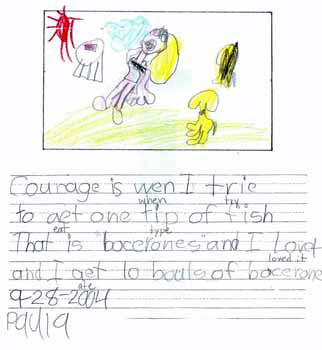
Figure 2. Paula wrote a personal story. 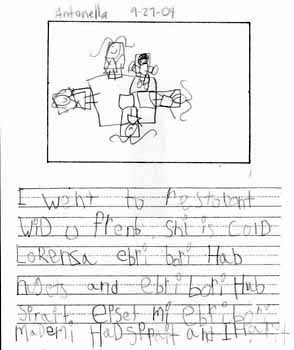
Figure 3. Antonella also wrote a personal story.
The children began to talk about their favorite foods and to represent them. They were then asked to predict whether they thought their selections were healthy or unhealthy.
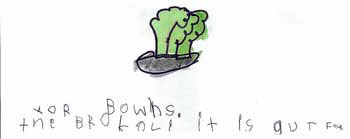
Figure 4. Michelle's favorite food is broccoli, and she predicted that it was good for her bones.
The Topic Web
The children represented their prior knowledge of food through a myriad of media. Some wanted to make still-life paintings of fruit. Others explored alternative materials as they played with plastic food and play dough. Some other children were interested in role-playing by creating a mini-market with a set of small plastic fruits, vegetables, and baskets that Gil had brought from home.
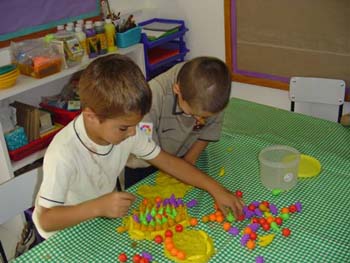
Figure 5. Alvaro worked with play dough.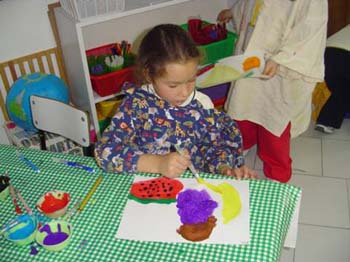
Figure 6. Paula painted. 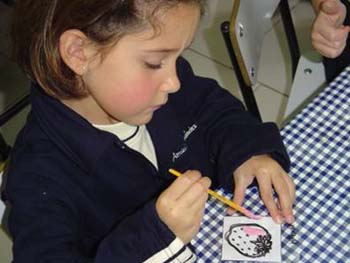
Figure 7. Amaia did window painting. 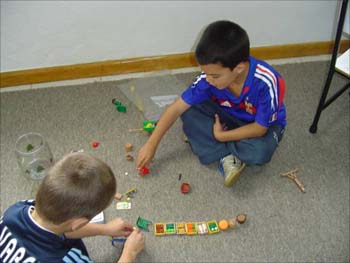
Figure 8. Gil and Ricardo role-played with their mini market.
The children participated in making a topic web that helped us envision different possibilities. What the children knew and wanted to know was becoming clear.

Figure 9. The children participated in making a topic web. 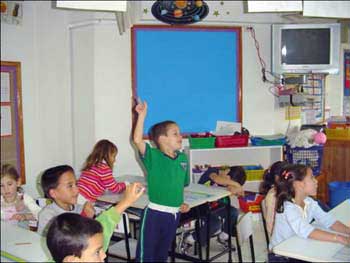
Figure 10. Most of the class participated.
During this phase of the project, I was everywhere, taking notes and most importantly detecting what the children were interested in learning. The children were constantly asking questions about what was healthy and unhealthy and why. As Gil talked with Ricardo, they started to wonder if they could just eat carrots all day—they were convinced it was okay because a carrot was a vegetable. I realized that their thought processes were becoming more sophisticated and that deeper understanding of the subject was needed. I noticed that they wanted to learn about the different food groups and the kinds of foods that would help them become healthier. I was honestly amazed at their interests and was delighted that our study was going in that direction. Even though I had an alternate route that I wanted to take the children (restaurant topic), I also felt that learning about the food groups was important.
Some children were excited to learn how to map out their ideas and work on their own topic webs. I limited their web topic in order to help them focus and get organized on their own, yet it was broad enough to get different ideas. The center of their web said: "What can we do to keep healthy?"

Figure 11. Natalie made a topic web.
The children had been coming up with many questions:
Antonella: Why are vegetables so good for you?
Gilberto: I wonder how many kinds of vegetables there are?
Begoña: Why is fish good for you?
I knew it was time to invite our first expert to talk about food and nutrition and to answer the children's questions.
Phase 2
A Nutritionist Visits
Alex, the mother of a child from another class and a practicing nutritionist, came to our class. The children had many questions, which they had dictated to me the day before in preparation for the expert's visit. They were then able to read their own questions to her. These are some of their questions:
Rafael: What vegetables help you see at night?
Matt: I wonder if you don't eat so many carrots, if you need a flashlight at night?
Michelle: Which vegetables are the best for you?
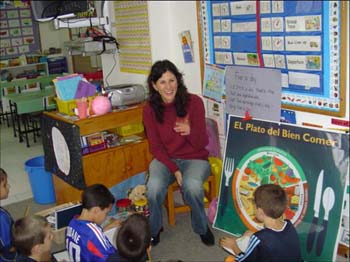
Figure 12. Our first expert was a nutritionist.
Alex taught the children about the different food groups and answered their questions. She also had food cards and played a game with the children that helped them classify the different foods into the food groups.
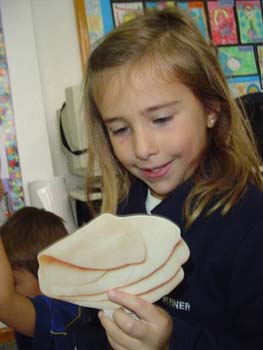
Figure 13. Valeria with turkey.
The children were then encouraged to record their eating habits. At school, the children transcribed the information into graphs. They were able to get an idea of the food groups that they were missing from their daily meals.

Figure 14. Rafael recorded his eating habits.
The form was divided into three sections—breakfast, lunch, and dinner. The children were asked to record what they had eaten in one day.
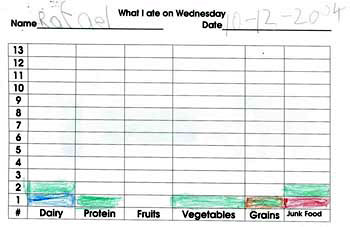
Figure 15. Rafael entered information into a graph.
Rafael then transcribed what he had eaten into a graph, where he was able to see which food groups he needed to eat more of. "I need to eat more proteins, fruits, vegetables, and grains," Rafael said concerned.
It was amazing to see how the children understood the importance of eating a balanced diet. Before I knew it, during lunchtime, the children were comparing their snacks and analyzing what food groups were included in their lunches. The children felt proud when they had food from all the food groups. One girl wrote a letter to her mother demanding a healthier lunch.
A child's mother came into the classroom to make fruit skewers with different dipping sauces. To the children's surprise, they discovered that they liked their skewers plain.
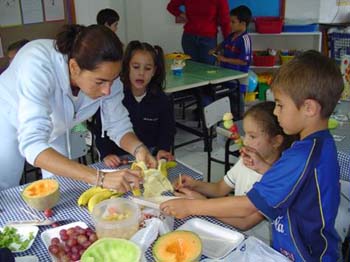
Figure 16. A mother showed the children how to make skewers.
Representation of Knowledge
I thought it would be interesting for the children to see Arcimboldo's work, an artist who painted portraits using only food and other objects (see http://www.illumin.co.uk/svank/biog/arcim/arcidx.html.) The children were fascinated by the ability of this artist to represent a portrait using only food products. They were eager to give it a try. Some even challenged themselves by making sure to include a balanced diet in their portrait.

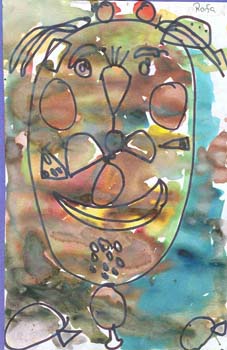
Figures 17-18. The children created portraits.
Nico described his self-portrait (Fig. 17): "The ears are made of cherries, the nose is a pear, the eyes are meats, and the mouths are peas." Rafael proudly described his portrait (Fig. 18): "I want all the food groups: the mouth is a banana, for fruits; the neck is a chicken drumstick, for protein; the hair pasta, for the grains; and there are tomatoes for cheeks, for the vegetables."
The children also wanted to represent their knowledge about the food groups using clay.

Figure 19. Valentina and Cynthia worked with clay. 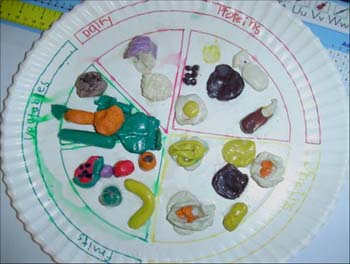
Figure 20. Valentina represented the food groups with clay.
A Site Visit
Amaia's mother invited us to visit their family's restaurant, and I thought it was the perfect time to go on a site visit. As soon as I told the children about this opportunity, they had many questions. I encouraged them to use our laptop computer and record them. This activity was a great opportunity for the children to practice their writing skills. The children used their "ear spelling" to write down words like they sound. Nevertheless, they also spelled many words correctly. These are some of their questions that they wrote without my help:
- JaU MENI PIPOL AR IN THE RUESTAURANT? Cynthia
- I WONDER HOW IS THE RUESTAURANT. Alvaro
- I WONDER WAT KIND OF FOOD DER IS IN THE RESTAURANT? Paula
- HAU IS THE KICHEN DO YOU NOU? Paula
- I wonder hau meni castemors der ar in a day? Antonella
- I wonder ho mene chefs der are? Sebastian
- I wonder wai ther sou meni chefs in a restaurant? Valentina
- I wonder how big is the restaurant? alvaro
- Hau moch food you hav? Arturo
- I wandr hawmeni pipol werk der? Michelle
- Uay do the chef kuoc so meone thengs? Gaby
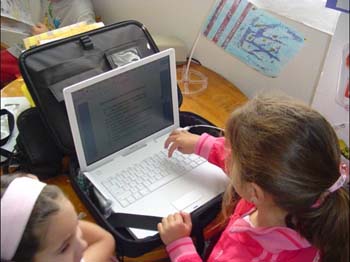
Figure 21. Valentina used our classroom's laptop computer to write questions.
The children were very interested and excited about our site visit. Some children even drew predictions of what they thought we would see in the restaurant. Ian predicted that he would see 1 kitchen, 30 chairs, 10 tables, 4,000 plates, and 1 television.
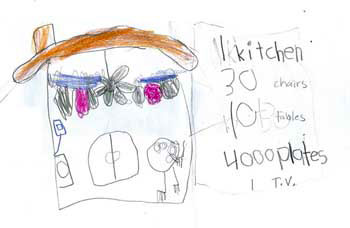
Figure 22. Ian predicted what he would see in the restaurant.
Sebastian's very elaborate predictions included 1 kitchen and 1 television as well, and he predicted that there would be 33 people working, 10 tables, 20 lights, 69 utensils, 8 fans, and 22 chairs.

Figure 23. Sebastian predicted what he would see in the restaurant.
We finally made our site visit to a restaurant called Angus. Amaia's mother, father, and I had talked about what the children could do during the visit; we agreed to take a tour of the restaurant lead by Amaia's father so the children could see everything in a restaurant—from the dining area, to the kitchen, to the storage area, to the bathrooms.

Figure 24. Amaia visited the restaurant's kitchen. 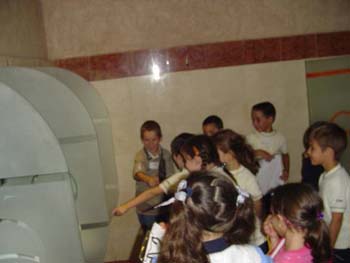
Figure 25. The children toured the restaurant's bathroom. 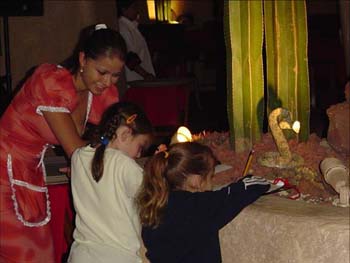
Figure 26. The children made field sketches.
Next, the children had a chance to take a closer look at things that interested them. They also had some time to work on their field notes and sketches. Begoña was fascinated with the waitresses' uniforms; she observed them carefully to include the details on her drawing. She was also interested in the table settings.
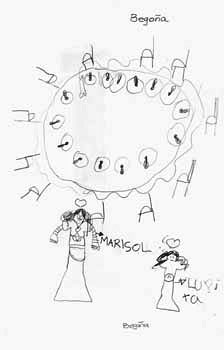
Figure 27. Begoña made a field sketch at the restaurant.
Then, the children were divided into subgroups (hostess's job, setting tables, storage area, bartending) so that they could revisit different parts of the restaurant and study their areas of interest in more depth. We did not include the kitchen because it was not safe for the children.
There were two girls who wanted to learn all about being hostesses. They learned from the hostess how to take reservations and how to seat the customers.
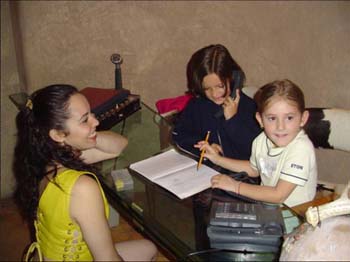
Figure 28. Antonella and Cynthia learned about being hostesses.
A group of children wanted to learn about the bar area and what a bartender does. They learned about taking an order from the waiters, but most importantly, they learned how to decorate and present a nonalcoholic drink. Valentina and Ricardo made glasses of lemonade with a twist. Ricardo suggested to Valentina: "Valentina, you stick the orange first and then the cherry—it looks better that way."

Figure 29. The children learned how to make glasses of lemonade with a twist.
The storage room was an area that some children were curious about because they had not known that it existed. They learned about the importance of having a storage area for food and drinks. They learned how to fill an order from the restaurant. Reading was suddenly important and a logical means to a necessary end. The clerk told the children: "You need to read this section [of the order] first and then check how many they need." Paola responded excitedly: "Oh, so you have to be a good reader!"
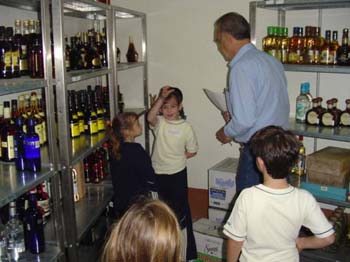
Figure 30. The children were interested in the storage room.
The children learned that setting up the tables, taking orders, and giving good customer service are part of a waiter's job. Many children were interested in learning about these tasks. They even learned how to fold napkins in a fancy way. "Which way does this side go?" Rafa asked. The waiter answered: "You fold this half first, then you pass one of the sides to the center." "I did it!" Rafa screamed.

Figure 31. The waiters taught the children to fold the napkins in a fancy way. 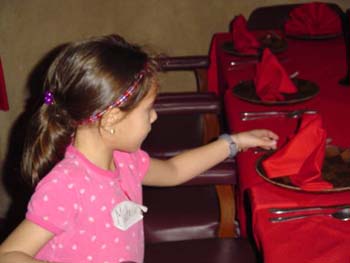
Figure 32. The children learned how to set a table.
A Second Site Visit
After our first site visit, the children started talking about setting up a restaurant at school. "We should start our own restaurant," said Michelle. "Yeah!" the class agreed. All of us began getting excited about the idea, but we agreed that we needed to find more information about restaurants before trying to open our own. In order to be able to see different kinds of restaurants and understand how they worked, we decided to take a second trip.
This time we would go to a more informal place where food was pre-made and customers served themselves. The children were curious about the differences they would see. These are some of the questions that I recorded:
Gaby: Is it big?
Natalie: What kind of food do they serve?
Arturo: Is it just as nice as the Angus?
Paula: How many waiters will we see?
Estrella, the owner of a restaurant called Stella Market, talked to us about her restaurant, and the children were able to ask her questions:
Alvaro: Why did you name it Stella Market?
Begoña: Why are the sandwiches packaged like that?
Valentina: Are the sandwiches healthy?
Amaia: What kind of food do you have?
We learned that Stella Market serves only salads and sandwiches and that it has a different way of serving their customers. We were able to go into the kitchen and observe how they prepared the sandwiches that were later packaged.

Figure 33. The children visited Stella Market. 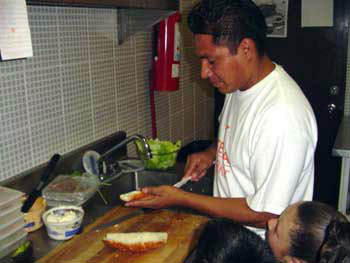
Figure 34. A cook at Stella Market prepared sandwiches.
The children were also able to role-play, pretending to be the customers or the cashiers at the restaurant:
Begoña: What would you like to eat?
Ricky: I want the chips!
Valeria: It will be 10 pesos please.
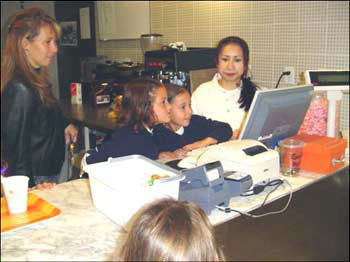
Figure 35. Some children acted as cashiers. 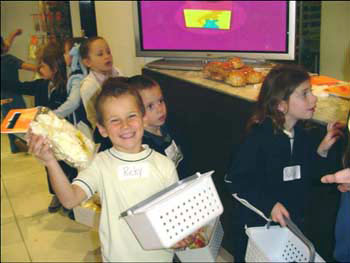
Figure 36. Some children pretended they were customers.
Some children worked on field sketches. They were intrigued by the way the food was presented.
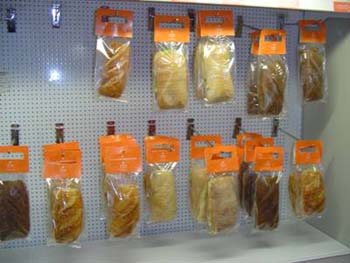
Figure 37. Sandwiches were displayed on a rack. 
Figure 38. A child made a field sketch.
We analyzed the differences and similarities between Angus Restaurant and Stella Market and made a Venn diagram. The children were separated into two groups, and with some teacher guidance, the children analyzed the two restaurants: Stella market is a ready-to-eat restaurant, and Angus Restaurant's food is made when you order. Angus is bigger and more formal than Stella Market. We also noted that Angus had waiters and Stella was self-serve with ready-to-eat food. Both restaurants sold food and had tables and chairs, although Angus had more.
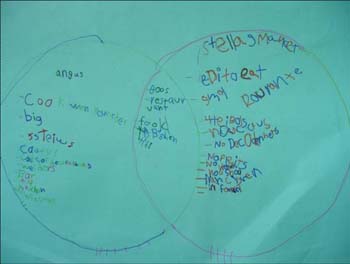
Figure 39. Children made a Venn diagram illustrating the differences between the restaurants.
Phase 3
After comparing the two restaurants, we decided that our culminating project would be a combination of the two restaurants.
We first needed to figure out how many people we wanted to serve at our restaurant. The children said, "the whole school!" I asked them whether they knew how many people were at school, and they didn't know, so we took on the challenge of finding out. We began by using concrete objects to count with—unit cubes representing tens and hundreds. This method is called Bancubi, a Montessori-based math method that the children are very familiar with. We counted 11 classes of 22 children. We then added 11 more units to represent classroom teachers, plus 10 more units for all the extra teachers and faculty.
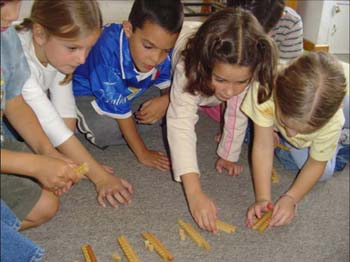
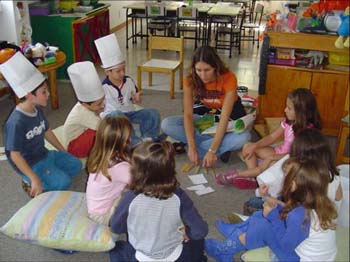 Figure 40-41. The children calculated how many people were at our school.
Figure 40-41. The children calculated how many people were at our school.
We added all the 10s and units and figured out that there were about 263 children and teachers. We realized that we could not handle so many people, so the children decided that they could each invite two people.
We then needed to find out how many people we would serve. Valentina figured out that it would be 2 guests for each of the 22 children and that would add up to 44 people, because 22 + 22 = 44. The children decided to round it off to 50, so we could invite the principal and any other staff member who would like to join us. Alvaro suddenly shouted: "We need to have 5 tables that sit 10 people each, and we need 50 chairs."
Revisiting Field Sketches
The children used our field sketches and the memory drawings to help us design and create our restaurant. They also realized that there would be some differences between the two restaurants.
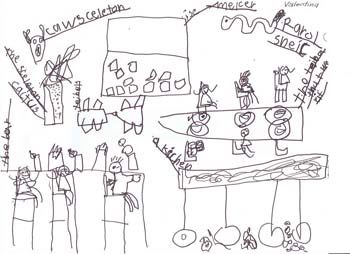
Figure 42. The children consulted their field drawings.
Lucy, Gil's mother, who is a chef, came to the classroom to teach us all about being a pastry chef. The children asked her many questions, including:
Sebastian: Why do you wear a big hat?
Nico: Why are you wearing white?
We learned that chefs wear all white to demonstrate that they keep a clean kitchen. We also learned that it was important to make the food look beautiful.
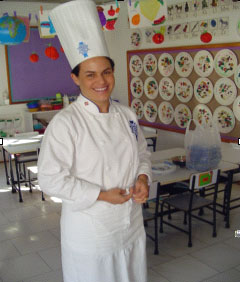
Figure 43. Our class had our own pastry chef. 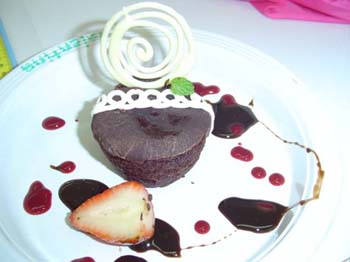
Figure 44. The children turned a cupcake into a gourmet-looking dessert.
Some children got interested in role-playing. They set the table, made menus out of recycled paper, and even prepared "paper" food for their customers. Children who weren't very outspoken were suddenly very vocal and participative. They were all very conscious that they needed to practice these different roles for the day when we would operate our real restaurant: "When we do it for real, you have to bring the food on a plate," Gil told the "waitress." "You need to be nicer," said Paola.
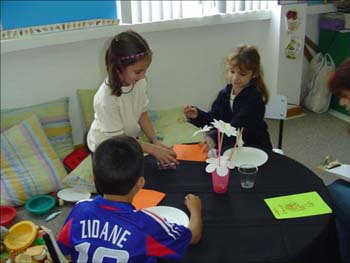
Figure 45. The children practiced different restaurant-related roles.
Other children were so motivated by the project and the restaurant preparations that they wrote little books about restaurant experiences and scenarios. Natalie wrote a short book on her experience eating at a restaurant with her mother. Natalie's story is actually a type of time line of a restaurant experience:
Title: When I Went to a Restaurant
Page 1: When I go to a restaurant, I always sit and then order my drink.
Page 2: I like to eat my food.
Page 3: When I am finished, I give my plate to the waitress.
Page 4: Then my mom pays the bill.
Page 5: And then we go home.

Figure 46. Natalie wrote a book about eating at a restaurant. 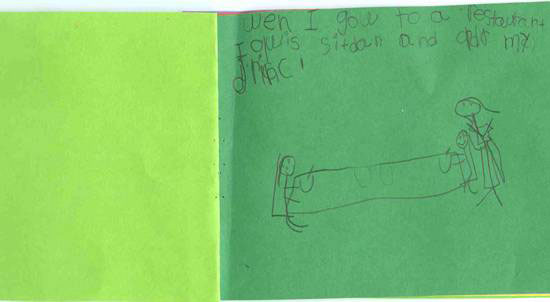
Figure 47. A page from Natalie's book.
Paola and Valentina's mothers came to the classroom to set up a buffet with the children. The children predicted what a buffet is: "a mailbox," "a chef," "something you put for food." However, through an actual experience, they learned what a buffet is (some realized they had already been to a buffet but didn't know what it was called), and they had a wonderful time doing it. The children learned that a buffet is a different way to offer food to customers. "I love this; you can pick whatever you want!" Paula concluded. "This is fun!" exclaimed Valentina. "Can we do this for every lunch time?" Arturo asked.
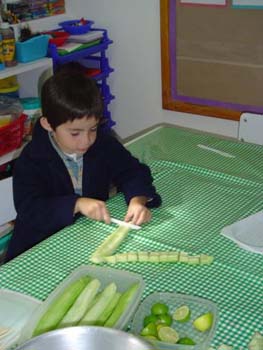
Figure 48. Rafael chopped some cucumbers. 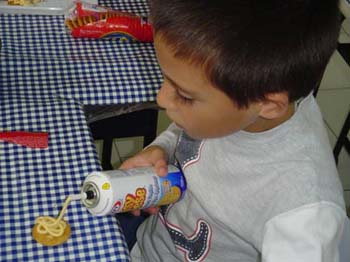
Figure 49. Arturo prepared cheese appetizers. 
Figure 50. A group of girls set up the buffet table. 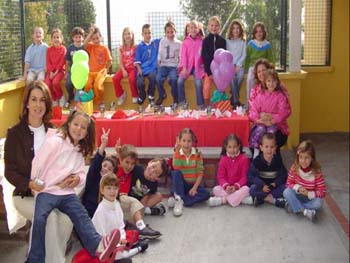
Figure 51. The buffet is ready!
The children were learning a lot about the different areas in a restaurant and ways of serving customers. They were anxious to start working on their establishment.
A group of children were interested in making a 3-D model of the restaurant using modeling clay. This activity turned out to be very valuable because as they were shaping and molding the different parts of the restaurant, different ideas were coming up. They noticed that we needed space for the kitchen, the bar area, the hostess table, and the buffet dessert table. Rafael realized we needed little trays for the bill and mints to go along with it. Ricky realized the tables needed some decorations. Valeria suggested flowers; Amaia noticed that the restaurant would need some decorations as well. Alvaro realized we needed to make menus. Andrea insisted we have entertainment. She thought a show would be an excellent addition to their restaurant. The children decided to take on all of these ideas. They had a lot of work to do, and there was no stopping them!
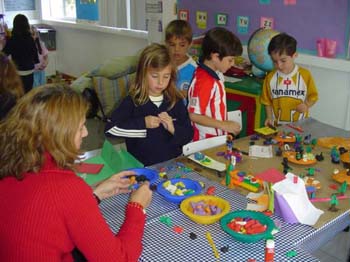
Figure 52. The restaurant model took about 4 weeks to finish. 
Figure 53. We finally finished it!
After many group brainstorming and voting sessions, the children decided on the restaurant's name: The Hawaiian Restaurant. This name was quite meaningful to the children because it reminded them of their field trip to Angus Restaurant where they commented that they felt as if they were in Hawaii because of the fancy glass decorations.
The teachers decided to serve cold food so that the children could prepare it. We also realized that the children didn't have access to, nor would it be safe for them to use, a stove or an oven. The children tried to offer a menu that would include all the food groups. They decided to serve salads and sandwiches. There would also be a dessert buffet table and different tropical drinks.
The children talked about possible staff uniforms. We ended up weaving Hawaiian skirts for the girls, which took a lot of hard work and participation from everyone, even some mothers. Gaby sketched possible staff uniforms and labeled each uniform: waiter—shirt, pants, and shoes; waitress—flower in hair, flower necklace, shirt, skirt, and sandals; cook—smock and pants.

Figure 54. Gaby sketched possible staff uniforms. 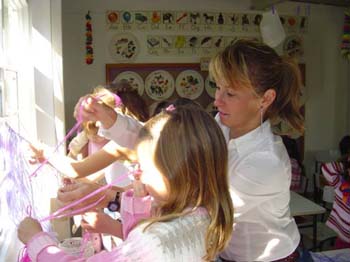
Figure 55. Mom's participation was crucial in getting things done! 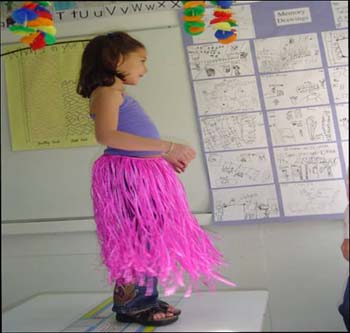
Figure 56. Michelle tried on a finished skirt.
We learned that leis are a big part of Hawaiian tradition after doing some research on the computer about Hawaii. The children decided that every staff member would wear one. Although they learned that leis are made from flowers, the children made ours out of crepe paper. In the end, they looked great!
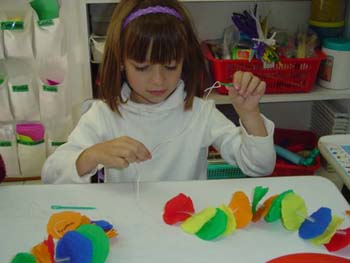
Figure 57a. Tara worked hard making a lei.
The chefs would each wear a chef's hat and a white T-shirt because the children learned that that is the official uniform to show that a chef keeps a clean kitchen. Rafael's mother volunteered to make all the aprons, and we then added the lei necklaces to match with the theme of the restaurant.

Figure 57b. The chefs wore white.
Cynthia's mother came in to help us design a mural for the restaurant. The children first made sketches and then transferred their ideas onto butcher paper. The children talked about Hawaii with Cynthia's mother. They thought about the ambience that they wanted to create. Andrea said, "There has to be a volcano and some palm trees!" "Flowers, a big sun, and lots of happy people!" added Cynthia.
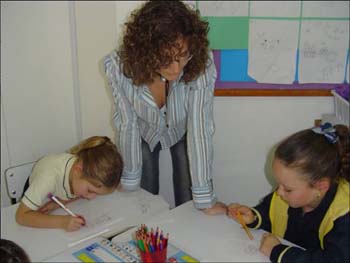
Figure 58. The children worked on the mural sketches. 
Figure 59. Drawings were transferred onto butcher paper to create the mural. 
Figure 60. We displayed the completed mural.
Paola's mother decided that we needed to serve nonalcoholic piña coladas, so she came in and showed the children how to make them. "In order to make a delicious piña colada, you need ice, pineapple juice, coconut cream, and a blender," Paola's mother explained. "It's yummy!" concluded Paola.
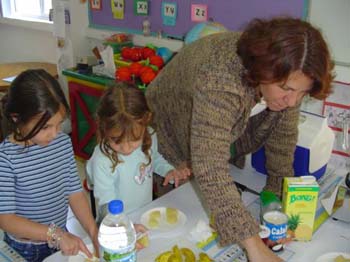
Figure 61. Paola's mother taught the children how to make nonalcoholic piña coladas. 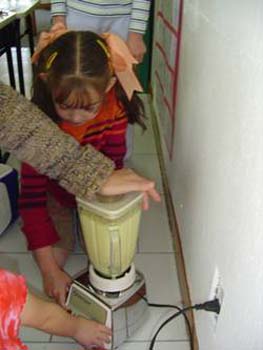
Figure 62. The blender was crucial for a good piña colada. 
Figure 63. The piña colada was tried and proven delicious!
Four mothers came to the classroom as cooking experts, and each shared her best sandwich recipe. The class was divided into four groups, and each group prepared a sandwich. Everyone tasted each menu item. The same was done for the salads. The children listed the names of the salads and sandwiches on a menu:
Hawaien Salad
Tomato, harts of palm and golf dresingPopeye Salad
Latus, spinach, tomato, harts of palm, and Musterd dresingSupr Rose Salad
Letus, rose petols, kramberis, speshi dressingThe Vegy Yumy
Chapata bread, avocado, Panela, spinach, Cucumbers, letes, and mayoThe Bacon Sandwich
Bacon, tomato, avocado, lattus, olev oil, and saltJuanito Peres
Boliyo, bins, ham, tomeito, manchego, avocado, and mayo
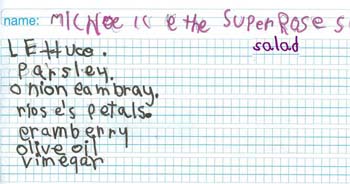
Figure 64. The children wrote down the recipe. 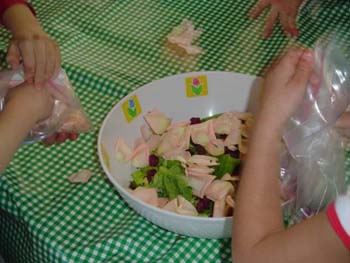
Figure 65. The recipe was prepared by each group of children.
Table decorations were needed, and so we formed a small group that would be in charge of the flower arrangements. The children in this group volunteered to be the "flower group." Ms. Yvonne, our school director, was the expert for the job. The children learned all about flower arrangements from books that Ms. Yvonne brought, and because the decorations were for a Hawaiian restaurant, the children investigated Hawaiian flowers.
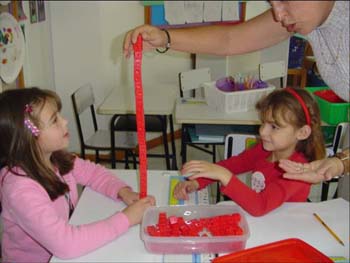
Figure 66. The children used Unifix cubes to figure out the height of the flowers.
Ms. Yvonne and the group then talked about the colors of the flowers in relation to the tablecloths.
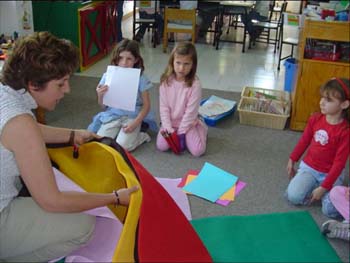
Figure 67. The children discussed the flowers in relation to the tablecloths.
The children worked on writing and illustrating an informative booklet of the different flowers we would use in our arrangements. The booklet included a picture of each flower in the arrangement, an observational drawing, and the name of each flower.
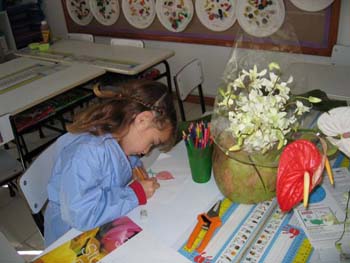
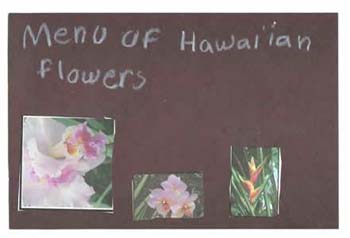 Figures 68-69. The children created booklets about the flowers.
Figures 68-69. The children created booklets about the flowers.
Gaby and Valeria figured out how much money we would spend on flowers. After calculating how many flowers were needed in each arrangement, they needed to calculate how much it would cost to buy them. After coming up with the total—1,250 pesos, Gaby said: "This is the hardest math I've ever done."

Figure 70. Gaby and Valeria calculated the cost of the flowers.
Ms. Yvonne brought some flowers for the Flower Group in order to work on a sample that everyone in the class could approve. Our classroom had a beautiful arrangement for the rest of the week.
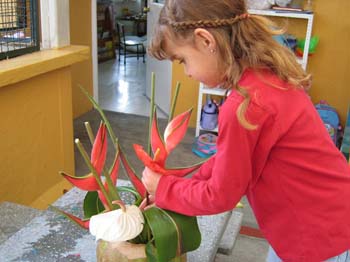
Figure 71. The children created a sample of a flower arrangement.
And approved it was!
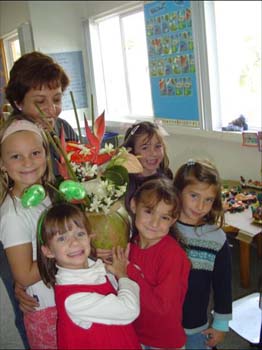
Figure 72. The class approved the arrangement.
The menu was an important part of the restaurant. We were very lucky to find special software in our computer that helped us design our menu. I played around a bit with the software, and after determining that it was user friendly, I assisted the children. All we had to do was choose a design and insert our restaurant information.
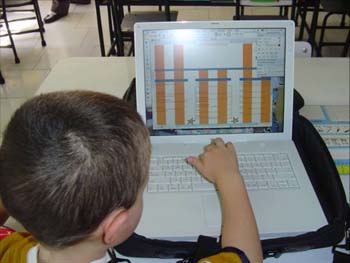
Figure 73. Sebastian used the menu application to insert the information for our menu. 
Figure 74. The first part of the menu. 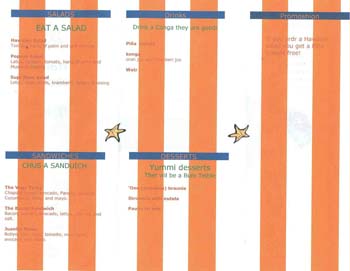
Figure 75. The second part of the menu.
While the children were making the menu, Rafael decided they needed to offer a promotion: "If you order a Hawaiian salad, you can get a piña colada free!" This activity allowed the children to learn a little about marketing. We decided to set a fixed price menu in order to make it easier for our cashiers. For a set price, customers could have one salad, one sandwich, and a drink, and customers could choose what they liked from the desserts on the buffet table.
Olivia, our in-house expert who runs the cafeteria, helped us figure out how much of each ingredient the class would need to buy. She first calculated the quantity that was needed for one person, and then together we considered how much we needed for 50 people. She also told us we should not plan every dish for 50 people because not everyone would have one of everything. After coming up with the quantities needed, we were able to develop a budget and thus set the price per person.

Figure 76. Olivia taught the children how to figure out how much food they would need to buy. 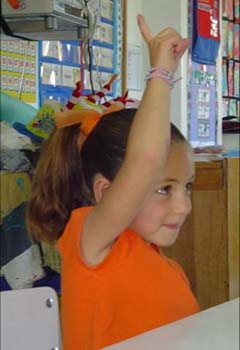
Figure 77. Valentina figured out how many pieces of bread we would need for 20 sandwiches.
This was a wonderful opportunity for the children to use their math problem-solving skills.
Olivia: How many slices of bread do we need to buy if we plan to make 20 bacon sandwiches?
Valentina: We'll need 40, because each sandwich needs two pieces and 20 + 20 is 40.Miss Vanne: If there are 5 hearts of palm in a can and we need 45 pieces, how many cans do we need?
Amaia: 9 cans.
Miss Vanne: How did you figure that out?
Amaia: I counted by 5s.
Andrea's idea for a show was well received by a group of children. We asked our dance teacher to help us choreograph a dance. Professor Eduardo taught the children the steps of their dance, and they practiced during recess and class time. We used a song from the Lilo and Stitch movie that Begoña had brought to class.
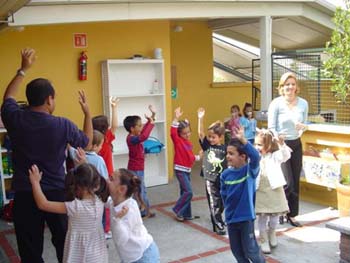
Figure 78. The show group rehearsed for many days.
In art class, the children made one-of-a-kind plates, napkin rings, clay utensils, and individual place mats. The utensils and the napkin rings were made out of clay, the plates were painted with special markers, the place mats were made out of cloth that the children later tie-dyed.
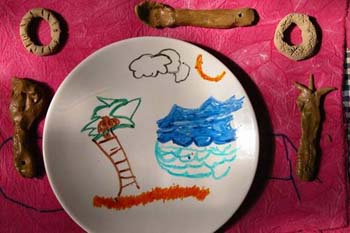
Figure 79. Example of a plate on a mat. 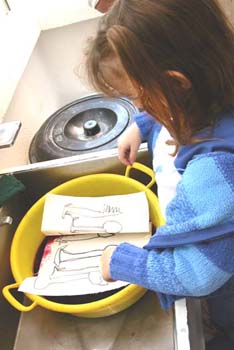
Figure 80. The children dyed the place mats. 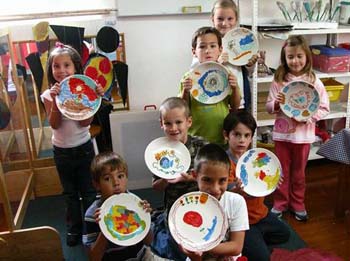
Figure 81. The children proudly displayed their plates.
The children realized they needed more plates, silverware, tables, and chairs, but they were not really sure where to get them. Miss Yolanda helped solve this problem by lending us, not only her plates, but her silverware as well. Now we would only need the tables and the chairs. The children decided to rent the tables just like some of their mothers had done when they had big events. The school would lend the chairs.
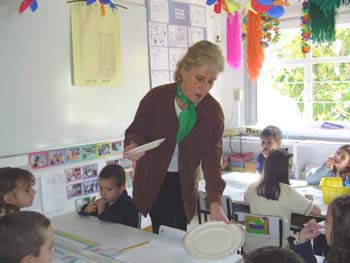
Figure 82. Miss Yolanda showed us her plates and silverware.
The waiters were having a bit of a hard time remembering how to set a table. So I told them a puppet story about Fork, Knife, Spoon, Napkin, and Plate Mountain. I got this story from Joyce Davis at a National Association for the Education of Young Children conference. I needed to make puppets out of the utensils, so I put googly eyes on them and added some other props such as hair and a tie. I told the story to the children, and they loved it. Some students retold the story during free times and reviewed where to put each utensil around the plate. Valentina even made her own puppets at home.
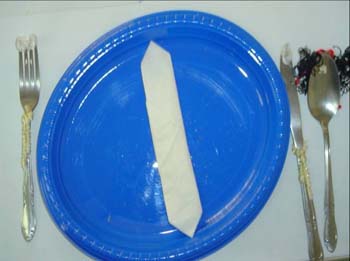
Figure 83. Table setting puppets. 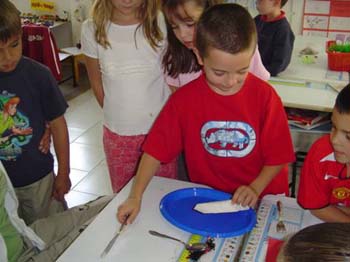
Figure 84. Children practiced retelling the story.
The children were ready to tell the parents about our restaurant. They dictated a letter to me to send to their parents, informing them of the opening of the Hawaiian Restaurant and letting them know that they needed to make reservations. Alvaro went through a few drafts before writing the final letter:
Dear Parents,
We have made a restaurant for you to come and eat, and it's yummy. We are going to make sandwiches and salads. If you need to make a reservation, come to our classroom, or you can call 0000-04-10 xt. 25. The restaurant will be open on the 1st of December at 11:15. If you would like to come, please make a reservation and tell us your name.
Sincerely,
Hawaiian Restaurant staff (limited seating 2 places per family)

Figure 85. Alvaro drafted a letter to parents.
Our classroom has a telephone, so we were able to take reservations right from our classroom. A small group of children came up with the words to be used when taking a reservation. The script was written by the children with some help from me: "Aloha Hawaiian Restaurant, can I help you?" ___, And your name is? ___ How many in your party? ___ Your reservation is confirmed for [this was a revision we made after we wrote it] December 1 at 11:00. Mahalo for calling the Hawaiian Restaurant."
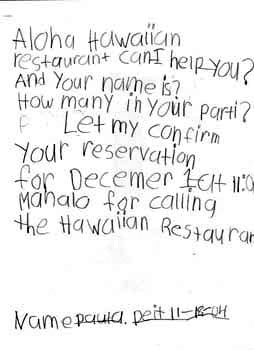
Figure 86. The children developed a reservation script.
Two days before the opening day of the restaurant, we took a field trip to the supermarket to buy all the groceries we needed for cooking. Sebastian and Paula worked on our shopping list, which we took with us to the supermarket.
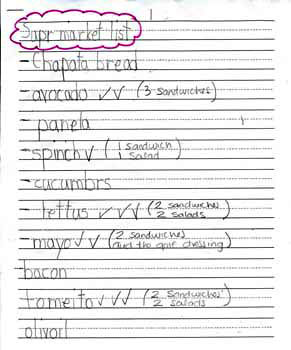
Figure 87. The children wrote a shopping list.
Our trip to the supermarket was successful. The children and the volunteer mothers were divided into five groups, and each mother was responsible for a team of five children. Each team had a list of foods from a food group. After getting all the ingredients on our lists, we met at the checkout counters.
Assigning Jobs
The children chose which area of the restaurant they wanted to work in. Their alternative roles included being a chef, waiter, host/hostess, dishwasher, bartender, or cashier.
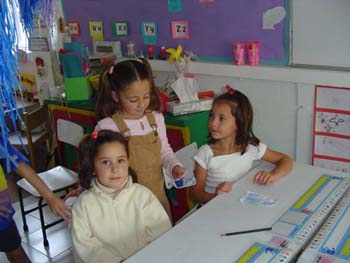
Figure 88. Waiters practiced taking orders and waiting on tables. 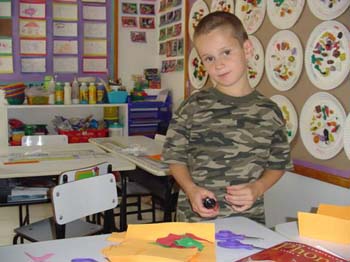
Figure 89. Chefs practiced preparing food with "paper food."
The day before the opening, the chefs, with two volunteer mothers, prepared the desserts and got the cold cuts ready.
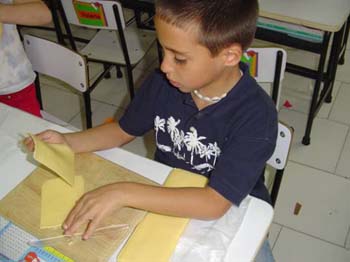
Figure 90. Arturo sliced the cheese. 
Figure 91. Antonella helped to make the brownies. 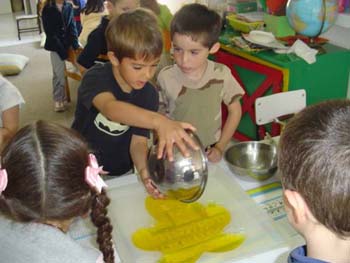
Figure 92. Alvaro put the Jell-O in the palm tree mold.
The big day finally arrived! The children were very excited. There was a lot of work ahead of us. The waiters set tables and included all that was needed: the tablecloths, the flower arrangements, the plates, salt, and different kinds of chiles.
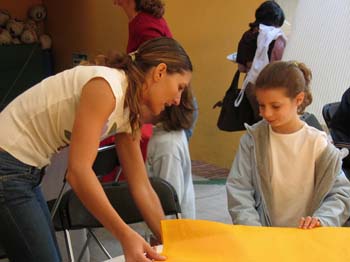
Figure 93. I helped Natalie place the tablecloth on the table. 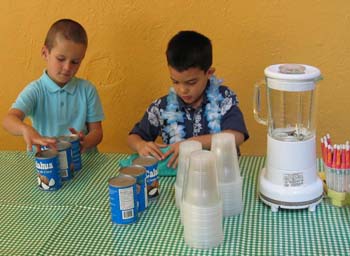
Figure 94. Gil and Ricky set up their bartending station. 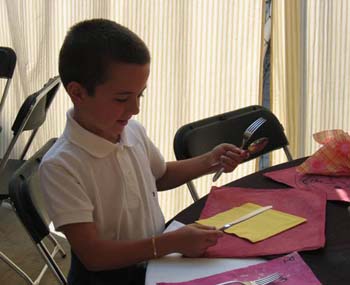
Figure 95. Nico set the table.
The seven chefs prepared the food beforehand in order to offer quicker service. Two mothers came in to help get all the food ready.
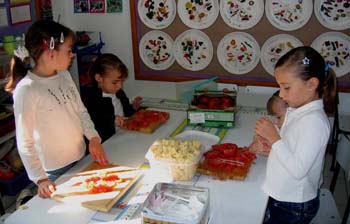
Figure 96. The children prepared the food. 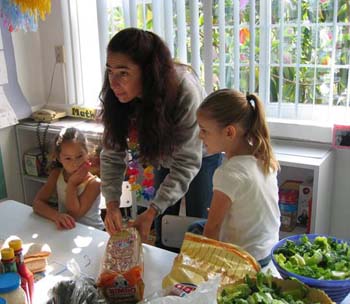
Figure 97. A child's mother helped us make the sandwiches. 
Figure 98. Gil's mother helped with the salads. 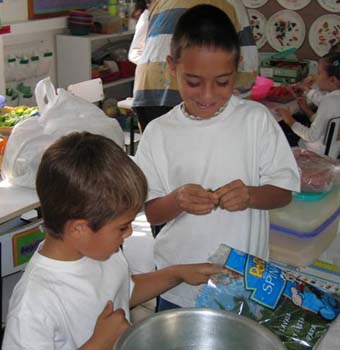
Figure 99. Alvaro and Arturo helped prepare the salads.
Welcome to the Hawaiian Restaurant
When the guests arrived, a hostess greeted them. They were welcomed to a beautiful restaurant where they could see a Hawaiian theme mural and incredibly well-set tables.

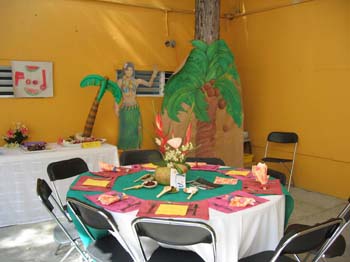
Figure 100-101. Welcome to the Hawaiian Restaurant!
All the food had label cards.
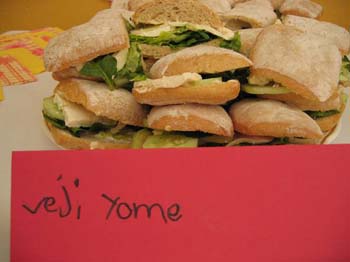
Figure 102. Example of one of the "Veggy Sandwich." 
Figure 103. Brownies on the buffet dessert table. 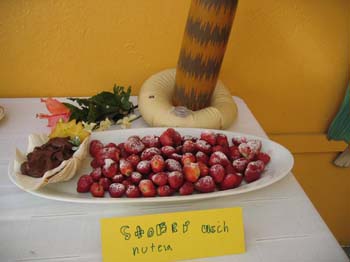
Figure 104. Strawberries with Nutella.
When the parents arrived, they checked in with the hostess before being seated. There were some parents who didn't make reservations, so the hostess had to tell them to please wait until all the people who had reservations were seated.

Figure 105. The parents needed to check in with the hostess to be seated. 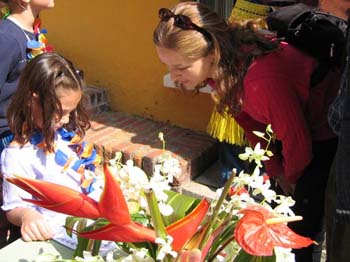
Figure 106. Michelle checked the reservation sheets to seat the customers.
As soon as the “customers" were seated, the waiters took their orders. The children had a checklist menu to help them take orders and to avoid mistakes when bringing out the food. The children would offer their "customer" a drink, and when they came back with it, they would take their food order. The waiters would then go to the "kitchen" and fill the order. They would check on their customers every chance they got to make sure they had everything they needed.
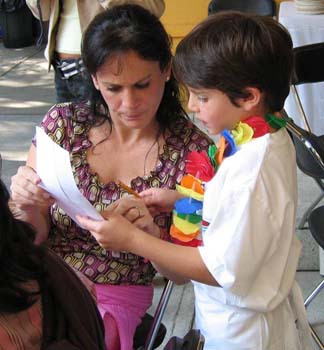
Figure 107. Ian took his mother's order. 
Figure 108. Chefs served salads. 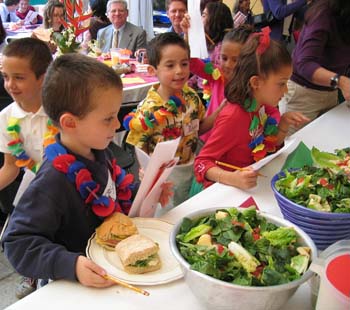
Figure 109. The children were very busy. 
Figure 110. Gil prepared piña coladas. 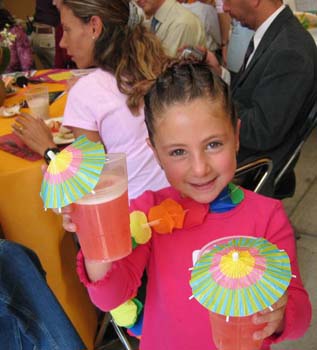
Figure 111. Valentina took some "congas" (prepared with orange and cranberry juice) to her customers. 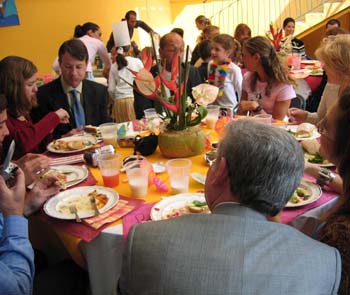
Figure 112. Happy customers!
After the 50 people were seated, the Hawaiian Restaurant was proud to present its show. The Hawaiian dancers performed with a lot of grace. The customers were so delighted that the dancers were received with cheers and lots of applause.
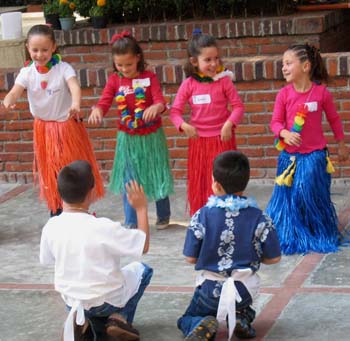
Figure 113. The Hawaiian Restaurant dancers.
In a restaurant, all jobs are important!

Figure 114. Arturo pulled a double shift as a dishwasher.
The cashiers had their work cut out for them. Customers asked for their checks at the same time. The cashiers had to figure out the meal totals and give change to the 50 customers at a relatively fast pace because many customers had to go back to work.
After a busy day, the staff got to try some of the delicious food.
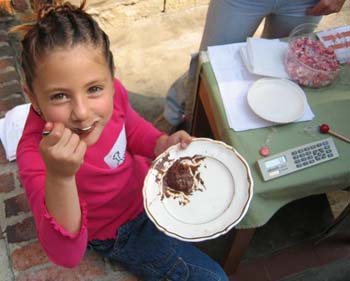
Figure 115. Valentina enjoyed some of the dessert. 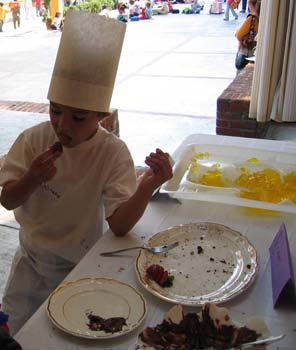
Figure 116. Alvaro ate some leftovers.
The Hawaiian Restaurant was a big success! The next day, I asked if anyone wanted to write about the experience. Several of the children wrote about their experiences. One child said: "I had a lot of fun. I was crying all night that I wanted to do the restaurant all over again." Gaby said: "I loved being a waitress, I loved it." Alvaro said: "When we do the restaurant I feel a very good thing."
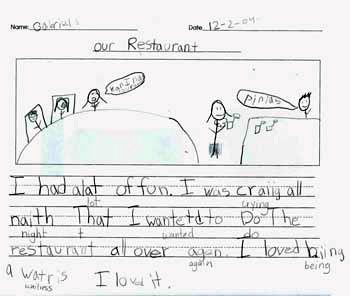
Figure 117. The children wrote about their experience. 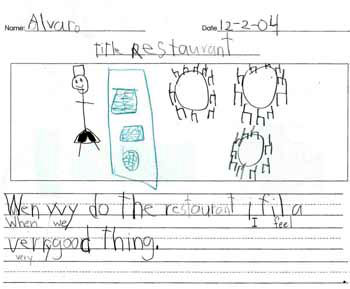
Figure 118. Alvaro wrote about the restaurant.
Conclusion
The Food and Restaurant Project was truly a valuable experience for all the children. The children began this journey learning all about the food groups and the importance of eating a balanced diet. They learned that each meal should include all the food groups. The children learned about vitamins, the foods that provided them, and why they are important. Our investigation on food brought us to our first field trip, which then led us to the restaurant part of the project, which led to more investigations, ending with the Hawaiian Restaurant. The children demonstrated their enthusiasm and motivation throughout the whole experience. At age 6, the children planned and implemented a dream—that dream became a reality and a success. And most importantly, they were empowered by their ability to have a say in their learning process.
Author Information
Vannessa Nacif obtained her master's degree in early childhood education from Tufts University. She has been teaching at Eton School for the past four years. If you would like to contact her, her email is missvanne@excite.com.

